In late May 2013, I co-led an Interfaith Peace-Builders (IFPB) delegation to Israel and the Occupied West Bank, including East Jerusalem, along with Josh Ruebner, author and National Advocacy Director of the US Campaign to End the Israeli Occupation. Though we reached the edge of Gaza, we could not enter due to Israel’s hermetic seal of the 360-square mile Strip. Over the span of two weeks available we sought to explore the impact of US foreign policy upon the Israel-Palestinian conflict. We travelled from the Jordan Valley to Lifta; from Jerusalem and through the cow herding stalls of the Qalandia checkpoint; from Dheishe refugee camp to surrounding, and enduring, Bethlehem; from the heart of Nazareth to the colony that sits on its highest points; from the ignominious parks of South Tel Aviv to the gentrified shores of Yaffa; from the resilient communities of Bil’in and Nahalin to the tortured streets of Hebron where militarized racial supremacy is painfully raw. Throughout the trip, the delegates examined how they, through US economic, military, and diplomatic aid, were complicit in this seemingly distant conflict. This was no exercise in Western voyeurism. In the course of paying taxes and letting elected representatives rattle off their allegiance to Israel without scrutiny, each of the delegates was both part of the problem and a key to its resolution. This is what, Josh and I, repeatedly emphasized.
In the course of co-leading the delegation, I had to contend with my own personal challenges. As much as I had worked, studied, and lived in the region, my American privilege had afforded a comfortable distance to speak as an advocate and scrutinize as a scholar. That convenient distance was swiftly dashed before arrival. Anticipating, as always, the reality of being denied entry, I traveled through the Allenby crossing. The rest of the delegates entered through the Tel Aviv airport. At the close of our second day, my interventions moved from the historical, the legal, and the political, to the familial, to loss, and to the fragility of futures. I preferred “objectivity” and its promised comfort but I could not escape biography and experience.
I struggled with the question of whether or not to publish this diary. Aside from the vulnerability that it both inheres and reveals, it embodies a voice with which I have not spoken in for many years. In a challenging exchange with two of my dearest friends and colleagues, I explained that the writing, and the trip more generally, felt like a regression to a place I had once been. To the beginning of my journey as an activist; to the first delegation I led to the region at age nineteen when I worked with Global Exchange; to the first stories I listened to and shared during my time at Dheishe refugee camp as an English instructor and later as a student at Hebrew University when the Second Intifada began. Then, as now, my reflections were raw. Their emotive thrust describes the resilience of survival and the violence of unrestrained state power at the expense of a more nuanced narrative and a more analytical inquiry. In doing so, I inadvertently created binaries of good and bad, victim and oppressor, helplessness and empowered thereby sacrificing the layered contradictions within spaces/societies in addition to the obvious ones between them.
One of my friends pointed out, for example, that I failed to mention the Palestinian Authority, its complicity in the occupation, and the associated networks of political and business elites who benefit from Oslo a single time. He pointed out that my description of Palestinians seemed to romanticize them as a singular unit. It’s true. Reading my essay, I was struck how naïve I sound in regard to Palestinians. I omitted my reaction to the socio-economic stratification plainly evident in the largest Palestinian cities. Some Palestinians are doing quite well and have developed a vested interest in perpetuating the peace process industry. Others, mostly youth, could care less about the Palestinian question and seek prosperity and a semblance of normalcy in their daily lives. Nor did I reflect on how NGOs have supplanted politics in Palestinian society and how this has stunted more vibrant mass movements.
I did not discuss my indignation when one of our speakers refused to look me in the eye when he shook my hand to say goodbye; intuitively, I thought he disapproved of my exposed hair. I refrained from discussing internalized racism that afflicts colonized societies who struggle against Eurocentrism as a normative construct. In particular, I did not share my encounter with a beautiful six-year old girl who hoped to become more fair-skinned when she grew up. Her mother enthusiastically pointed to me and told her daughter, “See, she is dark-skinned and is an attorney, tomorrow you will become a great doctor.” Her immutable dark-skin may prevent her from possessing beauty but would not preclude her professional success. In Hebron, I was annoyed by the tone of one of the Palestinian speakers. It was bombastic and sounded much more like a speech at a mass rally than a discussion with a sympathetic audience. Rather than reflect on it in my diary, I made excuses for him as he spoke. I left out my awkward experience in Sheikh Jarrah when Umm Il-Kurd said in Arabic, “Americans do not like Jews and that’s why they send them to us.” As the only Arabic and English speaker in that moment, I hesitated to translate what she said for fear of exposing her to criticism. After thirty-seconds of silence, I translated her words verbatim for the sake of integrity. My diary did not capture any of this nuance.
My other friend and reader, who possesses a close knowledge of Israeli society, was struck by my two-dimensional description of Israelis. She knows I know better, so what is going on, she asked. She too is right. I did not discuss our meetings with the Boycott From Within movement whose Israeli civil society leadership explicitly support BDS campaigns despite the high personal costs they incur among their society and from the state. I did not mention our meeting with New Profile leaders who seek to demilitarize Israeli society not just because of state violence meted against Palestinians but also because of the destructive and formative impact of militarization on young Israeli men and women. I did not explain that a representative of Zochrot, an Israeli organization dedicated to raising awareness about Israel’s ethnic cleansing project within Israeli society, guided us on our walk through Lifta. I did not reflect on the young Israeli activist who has dedicated himself to achieving dignity for the African refugees now stranded in Levinsky Park, who explained that he fears traveling to the West Bank because of the danger posed by Israeli soldiers.
Certainly none of these encounters demonstrates the existence of a vibrant Israeli left or a formidable opposition movement. To the contrary, most recent polls of Israelis evidence acceptance and approval of an explicit Israeli apartheid model. Despite the ability to vote freely, only a few thousand Israelis, if that, vote for Arab-Israeli political parties that strive for meaningful equality. Nonetheless, the omission of these meetings reifies an ethno-racial “us versus them” framework that I unintentionally constructed. My reader urged me to finesse my entries to mitigate the starkness of this binary but I could only do so much without sacrificing the rawness of the piece that made it a diary as opposed to an essay. Hence my struggle with publishing it at all…
Even after editing the original diary, the one before you now, I remained uneasy. It does not do justice to the layers of violence, historical depth, and struggles within each of these local encounters. It was simply personal. However, because of my conviction in the justness of the Palestinian struggle for self-determination, freedom, and dignity, I feared that the personal could appear unfair and even manipulative. Absent these binaries and rife with the complexity it deserves, I believe the justness of the cause would be just as piercing. Israeli settler-colonialism, apartheid, and occupation should not cease because Palestinians are good and Israelis are bad. Those structural conditions are an anathema to all whom they directly and indirectly impact—whether they happen to manifest across historic Palestine or elsewhere. Still, my writings reflected a jarring encounter with the brute crudeness of violence—as if I were discovering it for the first time. This, perhaps, is the power of bearing witness, over and over again.
Below is my diary of our eleven day journey into the heart of a people’s will to survive.
Day One (Jerusalem): All thirty-three members of the Interfaith Peace-Builders delegation has arrived. Two weeks of bearing witness (and committing to transformation) has begun
Day Two (Jerusalem): We covered Jerusalem today. We studied retroactive taxes, denial of housing permits, and center of life fire hoops. These were the cold and toxic maneuvers of Israeli bureaucracy that plucked out Palestinians one by one. It was a fierce study in just how “blind” the law is.
Like Chinese torture, compulsion here does not require dramatic fanfare. The administrative measures are an interminable march towards hegemony where conquest and pragmatism are indistinguishable. The state has revoked fourteen thousand residency permits from Palestinians throughout the West Bank since 1967 and counting. It has destroyed twenty-six thousand homes belonging to Palestinians…and counting.
In some instances the ethnic cleansing is outright brutal: building the Wall through homes, lands, lives, residency permit revocation, and settler take-overs. Rifqa Il-Kurd, (Umm Il-Kurd) is ninety-two years old and originally from Haifa. She has been living in Sheikh Jarrah, an East Jerusalem suburb since 1956. Sheikh Jarrah, along with Beit Safafa, Issawiyeh, Shu’fat, Silwan, and Beit Hanina, are all Palestinian suburbs of East Jerusalem that stand in the way of Israel’s master plan to Judaize the city. According to the Jerusalem 2000 Plan, Israel aims to change the ratio of Christian and Muslim Palestinians and Jewish-Israelis from a balance of forty to sixty percent to one of thirty to seventy by 2020. To do so, the state is building two national parks, an eastern ring road, and several other national environmental projects where residents cannot live, Palestinian residents anyway. It is only a matter of time before the state designates them suitable for Jewish neighborhoods.
While the state has used a web of administrative practices to remove the inconveniently present Palestinian families—it has exerted no such niceties upon the residents of Sheikh Jarrah. There, the state’s police forces have accompanied Jewish-Israeli settlers and facilitated their take over of Palestinian homes. Young settlers driven by a messianic calling have evicted Palestinians from their homes, settled in their place, and received adulation rather than contempt from Israel’s rule of law machinations. A group of such settler boys have taken over part of Umm Il Kurd’s home, which she built for her son and his family. He and his family now live elsewhere and visit their home occasionally. Daily, these settlers harass the matriarch; daily, they release their dog onto her, her daughters, and her grandchildren; daily, they taunt her that her days in her own home are numbered. In response, she tells the thirty-three American delegates that she will she will die in her home.
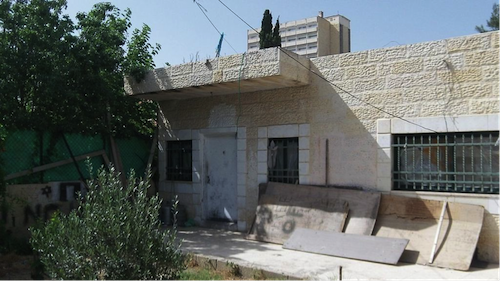
[Rifqa II Kurd`s home that is occupied by settlers. Image by Nuala Cabral.]

[Rifqa Il Kurd discussing the takeover of her home by settlers to the Delegation. Image by Dr. Ralph C. Watkins.]
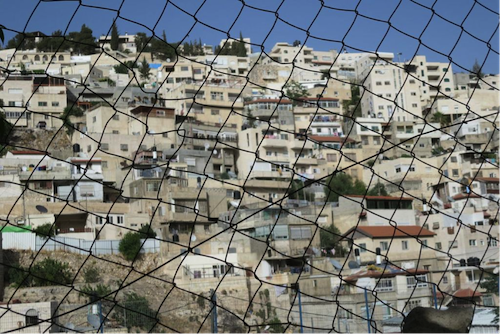
[Communities in Silwan forced to build vertically because of restrictive zoning laws. Image by Ilise Cohen.]
Day Three (Ramallah): The delegation spent a day in Ramallah, the most lively, dynamic, and vibrant Palestinian bantustan. Here, the delegates met with representatives of Palestinian civil society, human rights organizations, and a highly educated intelligentsia: Addameer, Al Haq, the Boycott National Committee, and Palestinians with Dignity.
The representatives spoke with piercing clarity and precision, provided vision and hope to resist the pounding arm of steady ethnic cleansing. Most of their work is either concentrated in Ramallah, because they cannot get out easily, or it targets an international community.
To the dismay of a Palestinian national body, frustrated with the counterproductive effects of Oslo, none of the approaches are perfect and none are constitutive of a coherent Palestinian national liberation project, which does not exist. Still, each is critical and indispensable to resistance in practice.
The need to resist is as urgent as ever. I can travel freely precisely because the state registers me as American and not Palestinian. I can travel along roads, unencumbered by checkpoints, makeshift roadblocks, and Jewish-only colonies. From this smooth expanse, we can clearly see the steadily shrinking space available to Palestinians and the suddenly available horizons for exclusivist Jewish-Israeli benefit. Internal criticism is good but it should aim to improve rather than to stall or paralyze.
.png)
[Image of Apartheid Wall separating Ramallah from Jerusalem. Image by Nuala Cabral.]

[Delegates walking through Qalandia checkpoint. Image by Dr. Ralph C. Watkins.]
Day Four (Erez, Sdoud/Ashdod, Jerusalem): We drove southwest today and reached the western edge of Gaza. We did not have permits to enter so we marveled at the enormous, militarized, high-tech crossing known as Erez, one of the five entry points into Gaza, and one of the four controlled by Israel. One point seven million Palestinians are stuck inside a 360-square mile strip, which the World Health Organization says will be "unlivable" by 2020. Somehow, though, when we speak of security, it is not about theirs.
We later met Moroccan Jews, or Mizrahim, in Sdoud, originally home to many of the refugees stuck in Gaza but which its poor refugee and Jewish immigrant population know as Ashdod today. The speakers discussed their involvement in the Israeli Black Panther party and their oppression and marginalization at the hands of Zionism. They likened themselves to Palestinians, explaining that in 1948, Israel forcibly removed 800,000 Black Palestinian Arabs and replaced them with 800,000 Black Jewish Arabs. But the state violence directed at them is quite distinct. Israel has ethnically cleansed Palestinians and seeks to continue doing so. In contrast, it desires the Mizrahim to stand in as expendable statistics at Israel’s ever-expanding borders and to serve as cheap labor in its market.
Throughout the day, American born and bred Jewish men who are now Israeli citizens discussed their involvement in the human rights movement including with B`tselem and Rabbis for Human Rights. They did not discuss how their immigration to Israel is part of the problem, a violent affront on Palestinian lives. Every Jewish immigrant emboldens the state’s demographic battle and the justification for its institutionally bestowed, racialized privileges. Nor did they acknowledge the ludicrous notion that the semblance of human rights in the Occupied West Bank and Gaza does not amount to Palestinian self-determination and freedom. Perhaps that makes sense since they are trying to save Israel from itself rather than trying to save themselves from an exclusivist national project.
Day Five (Jerusalem, Ramallah): Today we went to Yad Vashem. It translates into a name and a memorial. In Israel and in the United States, it is the Holocaust museum, a site of remembrance of the pain of a state-led genocidal project of Jews in Europe. The problem is that Israel manipulates this memory and this genocidal campaign to justify the creation of a Jewish state, which, by the definition of its own forefathers, must exclude non-Jewish Palestinians by design. In Jerusalem, this site of remembrance is built the remains of a demolished village, Ayn Karem. Just across from it lies the remains of the village of Deir Yassin, where the notorious 1948 massacre took place and what is today the site of a mental hospital.
Despite these intersecting layers of violence and pain, the most difficult place to be today was in the car of an Italian journalist as we drove from Ramallah to Jerusalem. I unintentionally cursed at the soldiers at the checkpoint, the arbitrary crossing where Palestinians and others must demonstrate their privilege to enter Jerusalem. I was sincerely sorry for not keeping my cool in the car, as I compliantly flashed my passport and bit my tongue.
The driver was not content. She took issue with me jeopardizing her job in Israel and told me to shut up since she had been trying to stay in Jerusalem for the past eight years. Her indignation is rightfully placed. The system is not any less forgiving of her because of her foreign identity. There are rules to obey when traveling in the region; a slight misstep could risk your movement privileges, your career, and your presence. Regardless of your courage, your willingness to sacrifice, your bravado, everyone knows better than to run their mouth at a teenaged soldier at a checkpoint.
Still, I could not wrap my head around her lack of appreciation for the difference between losing one’s job and losing one’s right to presence. I lost my temper for the sympathetic foreign journalist who had no conception of her privilege. My apology was insufficient because it was wrapped up in contempt for the system that now pitted us against one another.
Day Six (Lifta, Nazareth): It is striking how little Israelis know about Palestinians. Not just what they endure but who they are at all. There are few signs that signify the historic presence, agricultural production, commercial trade, or cultural influence of Palestinians. The signs that do exist are under threat for removal because of their threat to a national mythology that this was indeed a land without a people.
Lifta, for example, was home to 2,500 wealthy Palestinians who had two schools and a city center comprised of three spring wells. All of its residents fled by December 1947. We walked through its standing remains, which Israel has declared a nature reserve. Enduring limestone homes sprinkle the landscape. In one home, elaborate marble tile still lines an edge of the floor. High dome shaped ceilings still provide a cool reprieve from the searing sun. Stairs, doorways, hallways, window frames seem to ricochet with the sounds of playful children`s feet. Today, however, that did not concern the Jewish-Israeli visitors who swam in one of the spring wells. Nor did it concern the Jewish-Israelis who liked to use the abandoned homes to get high or the musicians whose jam sessions benefitted from the high ceilinged hollowed homes. But why should it? Nothing indicated that Lifta was ever home to Palestinians. In fact, most visitors think these homes are Roman ruins.
We continued our journey north to Nazareth, home to the "luckiest" Palestinian citizens of Israel. The city of eighty-thousand has a vibrant middle class, private schools immune from the Israeli curriculum where Palestinians do not exist, a recently activated tourist economy, and is the site of three hospitals. The “luckiest” Palestinians, however, are also a threat to Jewish dominance and control. So since 1956, Israel has built a settlement to contain, fragment, isolate, and survey the indigenous and numerically inferior citizenry: Netzeret Illit, or Upper Nazareth. The project to overpower the Palestinian population, totaling fifty-thousand Jewish-Israelis, has failed and in response, Upper Nazareth`s mayor has consulted Hebron`s Settlement Council for advice on how to curb the presence of Palestinians. In a few years time- Upper Nazareth will be home to ideologically-driven Jews who believe that Palestinians are stealing the land; the land they have always lived on of course. Hebron-like settlers in Nazereth, imagine.
However, even the most liberal Jewish-Israelis are part of a system that aims to erase, diminish, and marginalize Palestinians and competing narratives in general. The schools are segregated and horribly unequal; the public sector excludes Palestinian employment. The Electric Utility Company employs thirty-thousand people, six are Palestinian. The Water Utilities Company employs ten thousand people, four are Palestinian.
In Nazareth, we met Sally, a Palestinian woman who facilitates dialogue groups between Israeli and Palestinian women and children within historic Palestine. She explained that in many cases, Jewish children who have Palestinian friends at an early age sever their friendships by middle school because their parents fear that their friendships would dilute their enthusiasm to serve their mandatory Army service. Sally tells us that she has been opposed to dialogue groups for nearly her entire life. A few years ago she changed her mind because she felt that there were few other opportunities to challenge the state’s narrative from within.
She continued to recount how some of the Jewish-Israeli children insist that Israel’s founding fathers invited Palestinians to stay and live with them but Palestinians chose to leave. It is no surprise that Jewish-Israelis think that the whole world is biased against them and picking on Israel. In the obstinate and unchallenged bubble that they live in, that is exactly what it looks like.
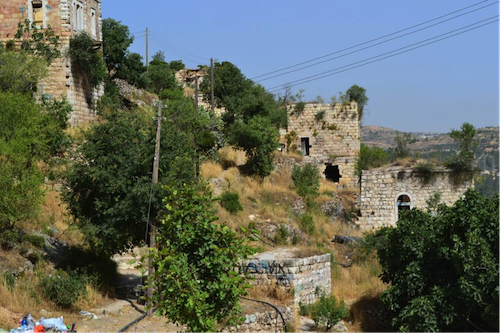
[Standing homes in Lifta. Image by Larry Hendel.]
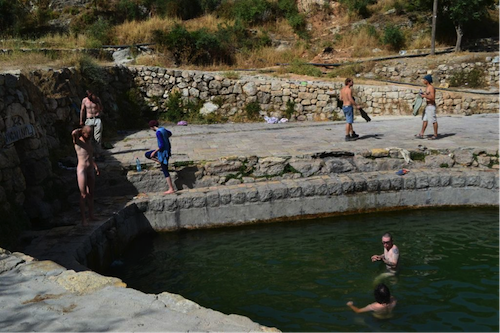
[Tourists and Israelis swimming in Lifta spring. Image by Larry Hendel.]
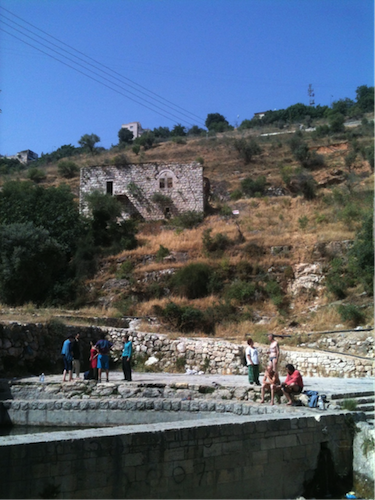
[Tourists and Israelis swimming in Lifta Spring. Image by Nabil Idrissi.]
Day Seven (Jordan Valley, Bethlehem, Dheishe refugee camp, Nahalin): Israeli state apparatuses are herding Palestinians into enclosed enclaves from within Israel to the West Bank. This violence is not a restriction on their freedom of movement, it is tantamount to their captivity. We drove from Nazareth to the Sea of Galilee, headed eastward towards the Jordan Valley, and then southwest to Bethlehem. Along the way we observed the same phenomenon: Israelis forcing Palestinians into concentrated areas, prohibiting them from expanding horizontally, and surrounding them with Jewish-settlers and cities. To prevent them from moving beyond their designated ghettos, Israel uses a matrix of laws, civil, criminal, and military to criminalize their movement.
Nahalin is just fifty kilometers outside of Bethlehem, it is in Area C, which constitutes sixty-two percent of the West Bank and which remains under full Israeli military and civil control. Nahalin is surrounded by four Jewish-only settlements: Gush Etzion, El-Ezar, Betar Illit, and Neve Daniele. Its location, or more aptly, the endurance of its Palestinian inhabitants, disrupts Israel`s ethnic cleansing. Because the Nassar family maintained its 1916 land deed, Israel has been unsuccessful in demolishing their homes and removing the family to Areas A or B. Instead, it has cut off their water supply and electricity. Worse, it enables the surrounding Jewish-Israeli settler population to violently harass them. In the early 2000s, settlers used bulldozers to place boulders on the main roadway from Nahalin into Bethlehem; it is a makeshift roadblock. Palestinians could easily remove the blocks but doing so comes with an exorbitant fine as well as a criminal conviction and a prison sentence. Instead, the residents trek twenty minutes up and down the hill each way. That is on a good day.
On one, not uncommon, bad day, the settlers uprooted three-hundred and fifty of the Nassar family`s olive trees while Israeli soldiers looked on. Today Amal Nassar explained to us that she once ran into a settler woman on her walk home and the woman asked Amal in which settlement she lived. Amal responded that she is Palestinian and she lives in the middle of the settlement ring. The settler woman, with a straight face, said, "No, you don`t. No one lives there." Amal must have imagined her existence, or perhaps she read it in a Palestinian textbook.
In Dheishe refugee camp, a group of young men explained that although the sea is only fifty kilometers away, the only large body of water they ever saw was during a workshop in Germany. They could not travel beyond Bethlehem, which is enclosed on all sides by the Wall. They cannot visit their original villages even for a day, they cannot visit a settlement, even if they wanted to, they cannot travel to other Palestinian cities in the West Bank unless they had twelve hours to spare, and they certainly could not go to Gaza. Remaining in Palestine for them means remaining in Bethlehem and for the rest of their lives. Ibrahim, a psychology and English literature graduate from Bethlehem University explained,
All I want is choice. The ability to decide where I want to live and how. I am not sure that I would return to my original village if I were given the right of return. I may choose to live in Haifa or Safad instead. But I want to choose. I think choice defines what it means to be human.
In this struggle, the battle is over whether humanity is a zero-sum equation, as ardent Zionists would have us believe, or whether it is infinite as the Palestinian refugees, stuck in one square kilometer camps and surrounded by state-sponsored settlers, claim instead.
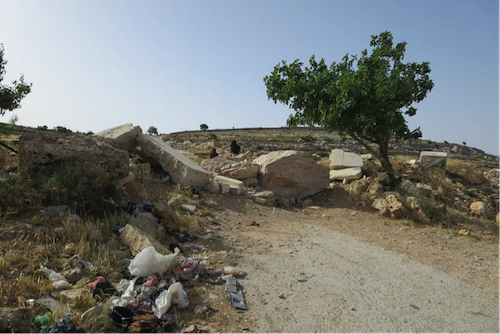
[Boulders placed by Israeli settlers and military to block main road to Nahalin. Image by Ilise Cohen.]
Day Eight (Bethlehem, Bil’in): Remember the Jordan Valley? It constitutes thirty percent of the West Bank and is fully under Area C, sixty-two percent of the West Bank under Israeli civil and military control according to Oslo.
As you travel along the expanse of the Valley, a gravel-paved street divides the stretch of land into two. On one side, acre upon acre of land, as far as the eye can see, is a green ocean of palm trees. Their lush branches dangle with dates that make up a one-billion dollar settler-colonial industry. On the other side are rolling dunes, parched earth, cacti and, here and there, a lone resilient palm tree where four-hundred thousand Palestinians used to thrive.
Since 1967, Israel has controlled the access to the most significant water sources lying under the West Bank- the northern, eastern, and western aquifers. Sixty percent of the Western Aquifer lies under the West Bank and Israel allocates eighty-percent of it for Jewish-Israeli use and leaves the rest for Muslim and Christian Palestinians. The Word Health Organization says that at minimum, each person should receive one hundred million cubic meters (MCM) of clean water. Palestinians in the West Bank consume seventy MCM, those in the Jordan Valley consume twenty MCM, and Israeli settlers each consume three hundred MCM daily.
The ethnic-based distribution of water intends to force Palestinians to leave Area C and move to Areas A and B where they can consume (a bit) more water. The Oslo Accords cemented this structural discrimination by disavowing international law and by agreeing to Article 40, which declared all water in the West Bank as Israeli State Property until the elusive Final Status Negotiations. Oslo also created the Joint Water Committee that controls the development of all Palestinian water projects wherein Israel has the right to veto any project. It is no coincidence that today the Palestinian population in the Jordan Valley is fifty-six thousand and dwindling.
In the afternoon, we drove up an unpaved road and when the bus stopped we had arrived in Bil`in. More specifically, we arrived at a slight incline of dirt. At its top, a growing olive tree marked the location where Bassem Abou Rahme took his last breaths after a soldier shot a tear gas canister at his chest from a proximate twenty meters and sent him tumbling down the hill. Bassem was one of Bil`in`s many residents whom Israeli forces have killed over the course of eight and a half years of weekly non-violent actions to protest the confiscation of 2,300 dunums of their land. The state planned on expanding the Modi`in Illit, an illegal settlement for Jewish people only, and, if completed as planned, the fourth largest city after Tel Aviv, Jerusalem, and Haifa. Israel began to build the Wall before it built the rest of the settlement and confiscated Bil`in`s lands to do so. Its fifteen hundred Palestinian residents refused to succumb to the state`s dictates or to wait for a broken court system to deliver them justice. After eight and a half years, several fallen martyrs, and countless injuries, the residents compelled the state to change the route of the wall and win back one-thousand dunums of their land in a struggle memorialized by Emad Burnat`s Oscar-nominated film, "Five Broken Cameras." As we sat under a tree in Bil`in`s fields, some movement`s leaders explained their struggle as not about the Wall or their lands in Bil`in, it is about their freedom throughout all of Palestine.
.png)
[Apartheid Wall at the edge of Bil`in. Israeli settlement on the other side. Image by Nabil Idrissi.]

[Children`s park in Bil`in. Israeli settlements in the background. Image by Nabil Idrissi.]
Day Nine (Tel Aviv, Yaffa): True, Israel may not be the most racist country in the world- its competition is quite stiff- but it is incontrovertibly the most self-avowed and self-righteous racist state.
Within Israeli society there is a stark hierarchical order. That order privileges Ashkenazi, or European Jews, above all others, namely Mizrahim (Middle Eastern) and Sephardim (Spanish), non-Jewish Russians, Ethiopian Jews, and well below the last rung on this racial ladder—the Palestinians. The non-white Jewish population is a majority in Israel but white Ashkenazi Jews control government, capital, and the highest military posts. As put by one of the founders of Windows, a Hebrew-Arab youth magazine: "To be accepted in Israeli society, you must be racist...the government convinces us that the only way that we can survive is by controlling others."
We saw yet another dimension of this racism in Levinsky Park this morning. Located in south Tel Aviv, the park has become an open-air non-shelter for African refugees who have been granted entry, but not absorbed into Israel. In its effort to whitewash its colonial racism, Israel has admitted entry to nearly forty thousand Sudanese and Ethiopian refugees. It will not, however, consider them for asylum. Instead, Israel pours the non-Jewish asylum seekers into south Tel Aviv, which was already a slum, and is waiting for the right opportunity to return the refugees from whence they came. Israel is a party to the Refugee Convention and assuming that it has given these persons temporary protection, it should provide them with shelter, education, health care, food aid, and the opportunity to work even if they are not eligible for asylum. Instead, this destitute African population can be penalized for working, though their employers are not punished for employing them...the neighborhood we walked through lacked a single urinal making every available corner into a site of public relief. As we left, one of the delegates lamented that we did not see Tel Aviv, I explained, this is Tel Aviv, just not the one Israel wants you to see, like much of the distorted face that it masks.
We were only a few miles away from Yaffa, one of the oldest cities of the world on par with Jericho and, historically, a beautiful Palestinian port. In early 1948, Yaffa was home to 80,000-120,000 Palestinians, as a result of war and an ethnic cleansing project, only 3,000-4,000 Palestinians remained after Israel`s establishment. We met a descendant of one of those few thousand Palestinians: a twenty-five year old leader of the Yaffa Youth Movement. The Movement aims to empower Palestinian youth and to resist their criminalization and erasure. He explained to us that Israelis have criminalized Palestinians for merely existing and "youth wear Reeboks so that they can easily run from the police when they need to."
Elsewhere in Yaffa, the municipal government is supplanting Palestinian landmarks with yuppy consumerist delights. The port, which no longer profits its original fisherman and where farmers no longer sell their infamous oranges, is the site of a series of Israeli artisan shops and exhibits. It seems that the state is eager to physically reconstruct history to ensure Palestinian marginalization and erasure. In Yaffa it is an art exhibit, in the Negev, it will be a forest, in most other places the state erects settlements. Licensed tour guides are unlikely to share this information as the Ministry of Tourism has institutionally denied licenses to Palestinians because of the danger their memory poses to the Zionist project and narrative. Today of the nine-thousand licensed tour guides in Israel, only three hundred are Jerusalemite Palestinians. There are no tour guides from Gaza or the West Bank.
Day Ten (Hebron): Hebron is the harshest site of structural and physical violence against Palestinians.
Settlers began to colonize Hebron in 1967 in what they regard as their "homecoming." They are ideologically motivated and are more committed to being on the land, which they believe belongs to them by divine decree, than they are to the State of Israel. Their nonsensical conception of divine real estate is upheld by the presence of three Israeli soldiers and a brandished automatic weapon for each settler together with complete impunity for their systematic attacks on Palestinians. Unlike other settlements that are built on Palestinian hilltops to facilitate the surveillance and control of Palestinians, the settler community in Hebron is built in the middle of the city. It forms a donut hole that geographically, socially, and economically fragments the entire city. There is nothing holy about Hebron today.
David Wilder, head of the Hebron Settlement Council and a US-born Jewish man from Cleveland, explained that whereas Hebron was off-limits to non-Muslims from 1260-1967, that today it is accessible to anyone and everyone. He does not mention that as a result of six hundred settlers in the middle of Hebron, the city`s two-hundred thousand Palestinians have lost one thousand homes, have had 1,800 of their businesses closed and confiscated, and must pass through a series of twenty checkpoints within their own city.
Issa Amro, a Palestinian born and raised in Hebron and a leader of Hebron Youth Against Settlements, knows David very well. Issa read us a letter that David sent to the Army in which he urges Israeli military forces to administratively detain the youth activist "for his own good." That is a euphemism for indefinite detention without charge or trial. David wrote the letter after Issa led a march of Palestinians and Israelis wearing face masks of Barack Obama and Martin Luther King Jr. on the day that Obama landed in Tel Aviv in March 2013. As Obama disembarked his plane, military forces beat and arrested Issa for his peaceful appeal for a just solution.
Issa believes he will be placed under administrative detention soon. The Army arrested him for incitement after he gave an interview to Al Jazeera Arabic where he described his group`s non-violent approach and activism. He protests the systemic confiscation of Hebron lands, the criminalization of its Palestinian population, and the policies aimed at forcing its residents to leave. The Old City, for example, has been all but closed. Palestinians must enter through revolving metal gates common to prisons to enter its narrow streets. Atop the destitute businesses that persevere in the Old City, settlers steadily colonize the rooftops. Those settlers throw garbage, stones, and even acid onto the Palestinians below to drive them out.
In response to a question about Baruch Goldstein, the Israeli settler who killed twenty-nine Palestinians as they prayed in the Ibrahimi mosque in 1994, David explained "You can count on one or two hands the Jews who have used violence that was not in self-defense." Another delegate asked him about the culture of fear within Israeli society. David, who wore a pistol on his hip, responded,
We don`t live in a culture of fear. Everywhere we go -we`re marked because someone wants to kill us...there are people who still want to wipe us out and we cannot depend on anyone else to protect us.
He proposes that parents of Palestinian children who throw stones be deported to Lebanon.
Issa, like all other Palestinians does not have a state, an international force, a pistol, or anyone, to protect him. Settlers physically assault, spit on, and expose themselves to Palestinians in Hebron as Israeli soldiers watch. The Army only intervenes if a Palestinian reacts in any way; then, the soldier detains the Palestinian. Issa explains, "I am a non-violent activist but I believe in defending myself. The problem is that I cannot." Under military law, Issa explains, he is guilty until he can prove otherwise while the Israeli settlers are innocent until proven guilty.
In the Orwellian and Apartheid reality of Hebron, self-defense is an ethnically-based category.
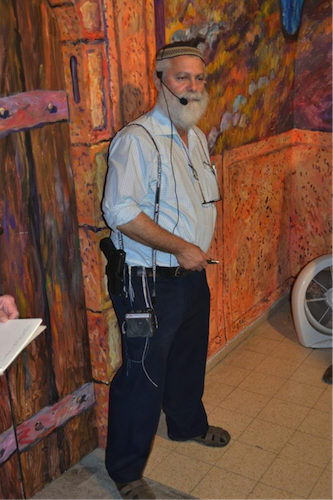
[David Wilder speaking to delegation in Hebron. Image by Larry Hendel.]
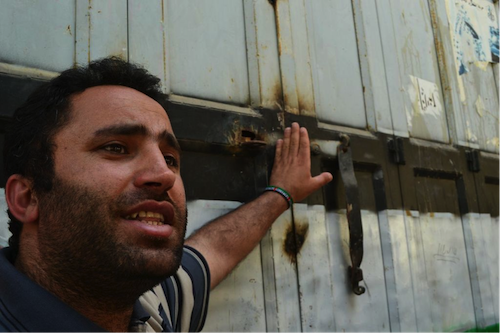
[Issa Amro shows delegation a Palestinian shop closed by Israeli military. Image by Larry Hendel.]
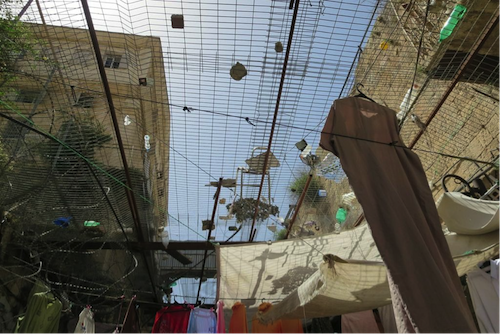
[Metal meshing protecting Palestinians in the Old City Hebron from settler trash and harrassment. Image by Ilise Cohen.]
Day Eleven (Jerusalem, Hebron): It is our final day and we are ending our journey with a closer look at Palestinian women. In conflict, women and children bear the harshest brunt of violence and deprivation. Their existing vulnerability is heightened both within the home as well as beyond its faintly reassuring walls. As Dima Nashashibi of the Women`s Counseling and Legal Aid Center explained, home demolitions, evictions, and forced displacement are women`s issues. Women are especially taxed as they innovatively find ways to provide for their families, to find alternatives to contaminated water, to ensure that their children continue their schooling, and to explain to the concept of militarized rainfalls. As conflict destroys local and national economies, women are the first to lose employment opportunities. As conflict destroys traditional livelihoods, they must continue to be the trusted conduits of cultural practices and custom. As conflict criminalizes their spouses and children, women remain the steadfast backbone of fragmented families.
Settlement expansion in the South Hebron Hills has exposed its families to extreme state and (state-sanctioned) settler violence. As we drove to At-Tuwani, Hafez explained how the Army declared his community`s lands a “Firing Zone,” literally a military zone where soldiers practice shooting. Firing zones forcibly displace the Palestinian families who live in them. Israel has designated eighteen percent of the West Bank for such practice. Along the way, we passed by the scarred remains of sixty olive trees that settlers had uprooted only weeks before. They left a sign in Hebrew taking credit for their violent attack; they will not be punished. Finally, we arrived at a stone home that belonged to Kifah Al-Adarah and her family.
Kifah is a pious Muslim. She sees her role as being a mother, a caretaker of her home, and as an aid for her husband and the other men who till their fields. When the Army confiscated a significant swath of their land, and hence, the livelihood it provided, her family`s income was severely reduced. To make up for that loss, Kifah mobilized At-Tuwani`s women to build a handicraft cooperative: they would cross-stitch bags, dresses, pillows, belts, cup holders, table cloths, and purses and sell it for a profit. The cooperative began with seven women, today it employs thirty-six.
With the money they raised, the women decided to build a school for girls so that they could continue their education beyond the sixth grade. In the course of construction, the Army arrested the men who built the school. In response, the community decided to continue their activities at night; the men built while the women kept a look out for military patrols. Together, they built one classroom at a time and invited teachers from nearby Tuba to work there. Today the school provides instruction through the eleventh grade.
After finishing her moving story of resilience and incremental triumph, a sympathetic delegate asked Kifah if she would like to reform Islam to improve the status of women. She quickly replied in the negative and explained that Islam afforded her the right to an education as well as to contractual rights within marriage. She fervently defends Islam but derides cultural norms amongst her community.
It is not clear how Kifah reconciles the relationship between religion and culture and, frankly, that is not what we visited her to discuss. Still, the fact that the delegates felt compelled to ask her about her relationship to religion reflects a broader obsession with Palestinian and “Middle Eastern” women, more generally. That obsession is fixated on religious reform and women’s clothing. This fixation is overly concerned with a warped Eurocentric understanding of women’s liberation. Moreover, it works to erase basic political and economic injustices that are constitutive of the societies in which women live.
For example, it makes little sense to discuss women`s rights in Gaza without addressing the economic agency necessary to empower a woman to make her own decisions and combat the patriarchy that afflicts her society, not unlike societies the world over. Unemployment in Gaza today, which has entered into the sixth year of a comprehensive siege, has reached 32.2 percent and among women it is seventy-seven percent. Addressing women`s rights in Gaza, should therefore be just as concerned with lifting the siege to improve its economy as it is concerned with her choice of clothing.
Kifah is not troubled by her headscarf. She chose to wear it. She would also like to make a lot of other choices concerning her life and the life of her children but may never be able to as the occupation, settler-colonialism, and apartheid tightens its heavy-handed grip.
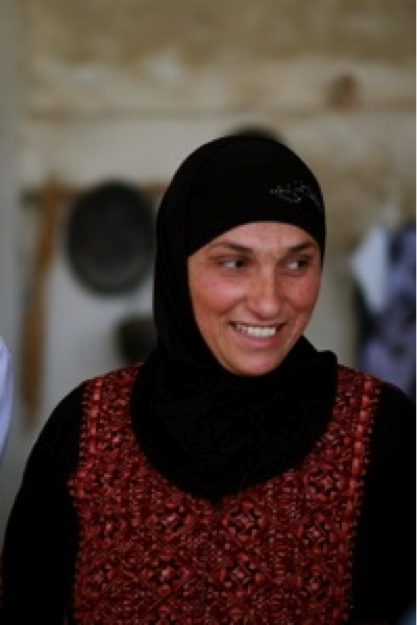
[Kiefah Al Adarah speaking to the delegation. Image by Dr. Ralph C. Watkins.]